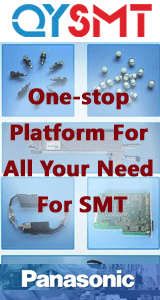| | | | | | | I need know the types, characteristic specials for temperature, general characteristics and all I need know about of manufacturer for BGA. | | | | | | | | | | | | | | I Hope than you send my information about this. | | | | | | | | | | | | | | | | | | | | Try this Link http://mot-sps.com/solutions/wired/pbga/pbga.html | | | | | | There�s a lot of Information on that subject to start with | | | | | | | | | | | | Wolfgang | | | | | | | | | | | | | | | | | Joel, and Wolfgang, | | | | | The information Wolfgang referred to on the Motorola web site is a condensed version of our BGA Tutorial, which covers package description, PCB design, assembly, rework, solder joint voids, and board level reliability. I will email to both of you the full tutorial, which will also have the latest information. Anyone else that would like a copy of the full tutorial can send an email request to me at T.Burnette@Motorola.com . Please include your company name, type of products you manufacture, and your business location, with the request. | | | | | | | | | Terry, | | | | | | | | Received quite a nice package. Thank you very much indeed. | | | | | | | | I do have one more question about what you folks have done as an alternative to immersion gold over nickel coatings. Would you be willing to share or comment this. | | | | | | | | Earl Moon | | | | | | | Earl, | | | We try to avoid using PCB's which have Ni/Au solder pads. Years back we encountered a problem with the phosphorus used in the nickel plating bath. Recently, one of our customers experienced a problem with Ni/Au pads on their PCB, that is being termed as "black pad". Two excellent papers were presented at the recent SMTA symposium on the black pad issue. The problem occurs with only certain pads on the board. The solder joints on these selective pads breaks prematurely, showing a dark nickel solder pad after fracturing. The papers which were presented indicated that a high ph level in the nickel bath, combined with certain board designs contributed to the problem. We use standard HASL finish on boards with devices that have >.032" pitch, and OSP copper pads on boards with devices that have <.032" pitch. | | | | | Terry, | | | | Thanks again. I've been going through the dark pad problem for two years and have knowledge of the problem. You were one of the first to alert me some time back. Referencing your reply, does board mean your BT/BGA substrate or the PCB on which the devices are mounted, or both. | | | | Also, I know this to be painful and I'm sorry to ask, but could you resend me the tutorial information at pod@ix.netcom.com. At work, I could not forward the package home where I need to prepare a report for Monday. | | | | Again, thanks for the very useful input. | | | | Earl Moon | | | Hi Earl, Terry | | seems to drift a little bit away but that Ni/Au topic is something I�m concerned about for that�s exactly the finish we are currently using. | How can I get more information on this ? | By the way Terry, after several hundreds of mail I didn�t get that link to the files you tried to send. Don�t know what�s wrong. | | Autumn is taking over... | | Wolfgang | | | | Wolfgang,
Terry first alerted me about the Ni/Au thing some time back. If he comes back to the forum, he'll tell more of his story. If not, Motorola informed me first and has information somewhere, other than maybe Terry, about the subject.
Aside from that, several articles and papers have been published concerning the so called "dark pad" phenomonon. H-P provided information to IPC and others - but I'll have to dig for it though someone here (Dave)has the author's name.
My findings simply are shocking. I mean, out of nowhere came a lot of boards with perfectly appearing Au/Ni boards meeting specifications, or so we thought.
After soldering BGA's to the surface, X-Ray was performed. The H-P laminographic machine's programmed rules provided little information other than possible excess solder. We could see nothing indicating poor solderability or wetting. Test found opens and, as usual, blamed BGA's.
One of our best operators looked closer at the peripheral solder joints. She detected a corner ball not wetting to a single pad. It had collapsed but did not effect a solder joint.
I removed the device, and some others. After site cleaning, though not really needed, close inspection revealed a single "dark" pad with no signs of solder wetting or gold.
After this incident, many other isolated pads appeared during a close to 100% inspection of all suspected boards in the lot. This was a shocker.
We tried "scraping" the pad surfaces but nothing. Finally, to save the future assemblies, I sent the boards back and had them stripped to bare copper and HASL'd. This worked but defeated the requirement as gold over nickel.
The problem is most plating chemistires contain phosphorous as a component promoting the process. Phosphorous, or probable alternatives (boron, or?) potentially have the same affect. As the gold is so thin (3-10 u") and pourous it is easily and negatively affected as a function of these properties, the nickel, and the phosphorous contained in its solution.
I don't have time to go on here and others are more qualified. Check for the papers I indicated and visit the IPC Technet forum archives for much more.
We use tons of this stuff here as we did at H-P. The comments from our resident "experts" is we haven't had to deal with that bag of worms yet - luckily.
Earl Moon
reply »
![]()
![]() I need know the types, characteristic specials for te...
- Sep 23, 1999
by
I need know the types, characteristic specials for te...
- Sep 23, 1999
by
![]()
![]() | I need know the types, characteristic specials for ...
- Sep 23, 1999
by
Wolfgang Busko
| I need know the types, characteristic specials for ...
- Sep 23, 1999
by
Wolfgang Busko
![]()
![]()
![]() | | I need know the types, characteristic specials fo...
- Sep 23, 1999
by
Wolfgang Busko
| | I need know the types, characteristic specials fo...
- Sep 23, 1999
by
Wolfgang Busko
![]()
![]()
![]() | | I need know the types, characteristic specials fo...
- Sep 23, 1999
by
| | I need know the types, characteristic specials fo...
- Sep 23, 1999
by
![]()
![]() | | | I need know the types, characteristic specials ...
- Sep 24, 1999
by
Earl Moon
| | | I need know the types, characteristic specials ...
- Sep 24, 1999
by
Earl Moon
![]()
![]()
![]() | | | | I need know the types, characteristic special...
- Sep 24, 1999
by
| | | | I need know the types, characteristic special...
- Sep 24, 1999
by
![]()
![]() | | | | | I need know the types, characteristic speci...
- Sep 24, 1999
by
Earl Moon
| | | | | I need know the types, characteristic speci...
- Sep 24, 1999
by
Earl Moon
![]()
![]()
![]() | | | | | | I need know the types, characteristic spe...
- Sep 27, 1999
by
Wolfgang Busko
| | | | | | I need know the types, characteristic spe...
- Sep 27, 1999
by
Wolfgang Busko
![]()
![]()
![]() | | | | | | | I need know the types, characteristic s...
- Sep 27, 1999
by
Earl Moon
| | | | | | | I need know the types, characteristic s...
- Sep 27, 1999
by
Earl Moon
![]()





.gif)

